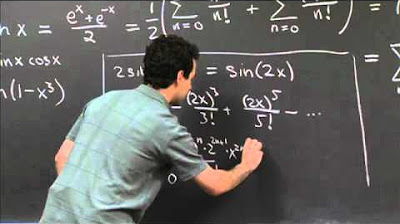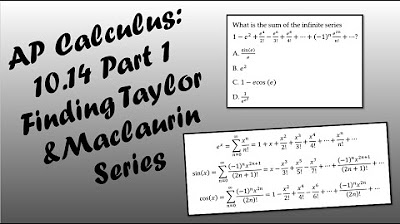Taylor's Series for sec(x) | MIT 18.01SC Single Variable Calculus, Fall 2010
TLDRThis video script delves into the computation of the Taylor series for the secant function, a topic not covered in lectures. It guides viewers to calculate the initial terms of the series, emphasizing the complexity of deriving higher-order derivatives. The instructor suggests leveraging the known Taylor series of cosine, due to the secant's relationship with cosine, to simplify the process. Two methods are highlighted: using the product of the secant and cosine series to solve for coefficients and employing long division on power series, providing alternative approaches to the direct computation of derivatives.
Takeaways
- 📚 The video discusses the computation of the Taylor series for the secant function, which does not have a simple formula for its series.
- 🔍 The general formula for a Taylor series is provided, emphasizing the use of derivatives at zero to compute the series terms.
- 📝 The first derivative of secant x is secant x times tangent x, and its value at zero is zero due to the tangent x term.
- 🔢 The second derivative of secant x involves a product rule and simplifies to secant squared x when evaluated at zero, resulting in a value of 1.
- 🔄 The process of computing higher derivatives of secant x becomes increasingly complex, with each new derivative involving more trigonometric manipulations.
- 🔗 The video suggests leveraging the relationship between secant x and cosine x, noting that both are even functions, which simplifies the Taylor series by eliminating odd powers of x.
- 🤔 The idea of using the product of the Taylor series for secant x and cosine x to equal 1 is introduced as a method to find the coefficients of the secant x series.
- 📉 By multiplying the known series for cosine x with the partial series for secant x, one can solve for the unknown coefficients through simple algebra.
- 📚 An example is given to find the coefficient for the x^4 term, demonstrating how the method can be applied to determine specific terms in the series.
- 📈 The video briefly mentions the alternative method of using long division on power series to compute coefficients, comparing it to polynomial long division.
- 🔑 Three methods for computing power series coefficients are summarized: direct computation of derivatives, using known relationships between series, and long division of power series.
Q & A
What is the main topic discussed in the video script?
-The main topic discussed in the video script is the computation of the Taylor series for the function f(x) = secant(x).
Why is the Taylor series for secant(x) not straightforward to compute?
-The Taylor series for secant(x) is not straightforward to compute because there is no simple formula for the entire series, unlike some other functions.
What is the general formula for a Taylor series of a function f(x)?
-The general formula for a Taylor series of a function f(x) is the sum from n=0 to infinity of the nth derivative of f taken at zero divided by n factorial times x to the power of n.
What is the value of f(0) for the function f(x) = secant(x)?
-The value of f(0) for the function f(x) = secant(x) is 1, as secant of 0 is 1.
What is the first derivative of secant(x), and what is its value at x=0?
-The first derivative of secant(x) is secant(x) times tangent(x), and its value at x=0 is 0 because tangent(0) is 0.
How can the even nature of the secant function simplify the computation of its Taylor series?
-The even nature of the secant function means that all the odd powers in its Taylor series have coefficients of 0, simplifying the computation by eliminating the need to calculate those terms.
What is the relationship between the Taylor series of secant(x) and cosine(x)?
-The relationship between the Taylor series of secant(x) and cosine(x) is that the product of the two series equals 1, since secant(x) is the reciprocal of cosine(x).
How can you find the coefficients of the Taylor series for secant(x) without computing all its derivatives?
-You can find the coefficients of the Taylor series for secant(x) by leveraging the known Taylor series of cosine(x) and the fact that their product equals 1, allowing you to solve for the coefficients of secant(x) through simple linear equations.
What is another method mentioned for computing the coefficients of a power series besides direct computation and using known relationships?
-Another method mentioned for computing the coefficients of a power series is long division on power series, which is mathematically equivalent to polynomial long division but starts with the lowest-order term.
What is the significance of the method of multiplying the Taylor series of secant(x) with the Taylor series of cosine(x)?
-The significance of this method is that it allows you to find the coefficients of the Taylor series for secant(x) by setting up and solving a series of simple linear equations, based on the fact that their product simplifies to 1.
Outlines
📚 Introduction to Computing Taylor Series for Secant Function
The script begins with an introduction to the topic of Taylor series, specifically focusing on the function f(x) = secant(x). Unlike some functions, there isn't a straightforward formula for the Taylor series of secant x, so the task is to compute the first few terms using the general formula for Taylor series. The formula involves summing the nth derivative of the function evaluated at zero, divided by n factorial, times x to the power of n. The first step is to compute the derivatives of secant x, starting with f(0) which is 1. The derivative f'(x) is secant x times tangent x, and at x=0, it equals 0. The process continues with higher-order derivatives, which become increasingly complex, but the script suggests leveraging the relationship between secant and cosine to simplify the computation.
🔍 Leveraging Relationships and Simplifications in Taylor Series
This paragraph delves into leveraging the relationship between secant and cosine to simplify the computation of the Taylor series for secant x. It is noted that since secant x is an even function, all odd powers in its Taylor series will have coefficients of 0, immediately providing half of the series' terms. The script then explores the idea of multiplying Taylor series, using the fact that secant x times cosine x equals 1. By multiplying the known Taylor series of cosine x with the unknown series of secant x, one can solve for the coefficients of secant x by setting up and solving simple linear equations. The process involves matching terms of the same degree and solving for the unknown coefficients, which is demonstrated by finding the fourth-degree coefficient, a_4, and mentioning a method to find the sixth-degree coefficient, a_6.
🛠 Alternative Methods for Computing Power Series Coefficients
The final paragraph introduces alternative methods for computing the coefficients of a power series. It briefly mentions the possibility of using long division on power series, which is mathematically equivalent to polynomial long division but starts with the lowest-order term. The paragraph summarizes three methods discussed in the script: the direct application of the Taylor series formula, using relationships between known and unknown power series, and long division on power series. It concludes by emphasizing the utility of these methods in computing the coefficients of secant x's Taylor series and suggests further exploration of the long division method for a deeper understanding.
Mindmap
Keywords
💡Taylor series
💡secant function
💡nth derivative
💡general formula
💡factorial
💡even function
💡product rule
💡trigonometric manipulations
💡coefficient
💡long division
💡power series
Highlights
Introduction to computing the Taylor series for the secant function, which lacks a simple formula.
Encouragement to compute the first few terms of the Taylor series for secant x up to the fourth term.
Explanation of the general formula for a Taylor series and its application to secant x.
Calculation of the first derivative of secant x and its value at x=0.
Derivation of the second derivative of secant x using the product rule and its simplification.
Observation that the Taylor series for secant x becomes increasingly complex with higher derivatives.
Introduction of a simplified approach leveraging the relationship between secant and cosine functions.
Use of the property that secant x is an even function to deduce the absence of odd power terms in its Taylor series.
Multiplication of the Taylor series for secant x and cosine x to derive the coefficients of secant x's series.
Solution of linear equations to find the coefficients of the Taylor series for secant x.
Identification of the fourth-degree coefficient (a_4) of the secant x Taylor series as 5.
Brief mention of an alternative method using long division on power series for coefficient computation.
Discussion of three methods for computing power series coefficients: direct formula application, relationship utilization, and long division.
Highlight of the practicality of leveraging known relationships between functions to simplify Taylor series computation.
Emphasis on the importance of understanding the properties of functions in relation to their Taylor series.
Illustration of how the even nature of secant x simplifies the computation of its Taylor series.
Demonstration of the process to compute higher-order terms in the Taylor series for secant x using the product of series.
Transcripts
5.0 / 5 (0 votes)
Thanks for rating:





